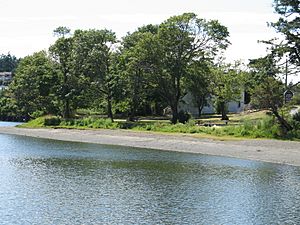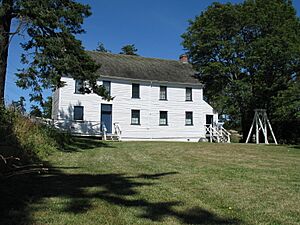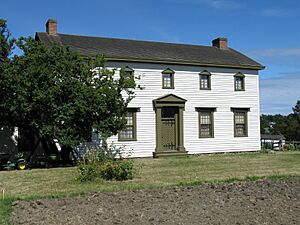Craigflower Manor and Schoolhouse facts for kids
Quick facts for kids Craigflower Manor and Schoolhouse |
|
|---|---|

Craigflower Farm from a distance.
|
|
| Type | Manor; schoolhouse; agricultural community |
| Etymology | The Craigflower Estate in Scotland |
| Location | View Royal (Manor) and Saanich (Schoolhouse), just north of the Craigflower Bridge at Admirals Road and Craigflower Road in Greater Victoria, British Columbia, Canada |
| Founded | 1853 |
| Founder | Puget Sound Agricultural Company |
| Built | 1853–1856 |
| Architectural style(s) | Georgian Revival |
| Governing body | Parks Canada |
| Website | Craigflower Manor archived |
| Designated | 1975 |
The Craigflower Manor and Craigflower Schoolhouse are important National Historic Sites of Canada. They are located near Victoria, with the Manor in View Royal, British Columbia and the Schoolhouse in Saanich. These sites feature two 19th-century buildings: a large house (manor) and a school. The Hudson's Bay Company had these buildings constructed to provide homes and education for their workers at Craigflower Farm.
The two buildings are close to the water, about 200 metres apart. They sit on opposite sides of the Gorge Waterway, which is now crossed by the Craigflower Bridge. These buildings have been central to the community for a long time. Today, they are open to the public as museums. They teach visitors about the early European settlement history of Victoria.
These sites are also very important for archaeology. They show evidence of human life from three different time periods, stretching back thousands of years. The buildings themselves are also very valuable. They are some of the best and last examples of their kind in Canada. Because of these reasons, both sites are protected by the government for everyone to enjoy.
History of the Site
The land where Craigflower Manor and Schoolhouse stand was shaped about 13,000 years ago. This was during the last ice age in North America. Huge glaciers carved deep valleys into the earth. These valleys later became small lakes and streams. Over time, these lakes connected to the ocean. They formed a saltwater inlet, which is now called the Gorge Waterway. The local Indigenous people call this waterway "Kosapsom."
The Lekwungen people, a Coast Salish tribe, lived in this area. They are the ancestors of today's Esquimalt and Songhees First Nations. They called the entire region "Camossung." This name comes from a legend about a girl they believed turned to stone there.
Archaeologists have studied the Gulf of Georgia, Vancouver Island, and the Lower Mainland. They have found different periods of human activity, which they call "culture types." The Craigflower Farm site shows three of these types: "Locarno Beach," "Gulf of Georgia," and "Historic." The "Historic" culture type refers to the time when Europeans settled the area. Most of the old objects found at the site are from this period.
The other two periods of human life are mainly known from a large shell midden found at the site. A shell midden is a pile of shells and other waste left by people who ate a lot of shellfish. This shows that there was plenty of shellfish and game in the area. The earliest period, "Locarno Beach," used many kinds of stone tools. These included tiny blades (microblades), adzes, and other sharpened objects.
The next culture type, from about 2500 years ago, is called "Gulf of Georgia." People during this time used more bone tools. They made wedges and sharp tools from antlers, and also used different kinds of wood. This culture type ended when Europeans arrived and settled Vancouver Island. In total, about 1000 Indigenous artifacts were found at the site during two archaeological digs.
Both the manor and the schoolhouse were part of Craigflower Farm. This was one of Western Canada's first farming communities. The Puget Sound Agricultural Company, a part of the Hudson's Bay Company, started the farm in 1853. Its purpose was to provide fresh food to the nearby Fort Victoria. It also helped with the settlement of lower Vancouver Island. The farm was named after the Craigflower Estate in Scotland. This estate belonged to Andrew Colville, who was the Governor of the Hudson's Bay Company from 1852 to 1856. The land for the farm was bought from the Esquimalt First Nation in 1850. They then moved to a nearby area.
Craigflower Schoolhouse
The schoolhouse was first called Maple Point School. Kenneth McKenzie, the first farm director, ordered its construction. He wanted to provide education for the children of the farm workers. This was the third school built in the colony of Vancouver Island. Governor James Douglas had called for schools to give "proper moral and religious training" to children. He felt this was especially needed for Protestant children. Roman Catholics already had good teaching from a priest.
Building the school began in August 1854, using timber from the farm. It was finished in late February 1855. The first students started classes there in March of that year. They paid a fee of between 30 shillings and 1 pound.
The schoolhouse is a two-story building built in the Georgian Revival style. It had one classroom on the first floor. The second floor had six rooms for the teacher, their family, and students who lived there (called boarders) from other parts of Vancouver Island. A large brick fireplace and a stove kept the building warm. A bell, saved from the wrecked steamship Major Tompkins, was hung outside to call students to class. At first, people could only reach the school by boat from the main farm. But in 1856, the first Craigflower bridge was built, connecting the two parts of the farm.
The schoolhouse became a central place for social and religious events on the farm. It was used continuously until 1872. At that time, the town council stopped funding Victoria's schools. However, changes to the Education Act soon brought the school back into operation. In 1873, education became mandatory for students aged seven to 14. The school continued to operate until 1911. It was then replaced by a second Craigflower school, built across the road. The current school, called Craigflower Elementary School, was built in 1964.
The original schoolhouse was turned into a museum in 1931. A local service club ran it until 1975. Then, the provincial Historical Parks board bought it and restored the building. For a short time, The Land Conservancy of British Columbia ran it as a museum. This schoolhouse is the oldest surviving schoolhouse in Western Canada. However, it is often mistakenly called "the first school built in British Columbia." Today, the Schoolhouse is home to the Hallmark Heritage Society. This is the oldest heritage preservation group in the Capital Regional District. It is open to the public for special presentations during the summer.
Because it had only one classroom, it is considered a one-room schoolhouse.
Craigflower Manor
The manor house was built soon after the schoolhouse was finished. It was meant to be the home and office for the managers of Craigflower Farm and their families. The house was designed as a Georgian Revival version of a Scottish manor house. This was at the request of Kenneth McKenzie's wife, Agnes. The foundation was laid in 1853, before the McKenzies arrived. The house was completed in May 1856.
The manor was a grand, two-story building. It was over 900 square feet (83 square metres) in size. It was second only to the first Government House in its elegance. The building had a dining room, sitting room, office, music room, kitchen, and four bedrooms for the large McKenzie family. Several fireplaces, served by two large brick chimneys, provided heat.
The manor was used as a home until 1922. Then, the Hudson's Bay Company changed it into a community centre. Later, Jean and Jerry Thompson bought it. They restored it and turned it into a bed & breakfast. The Thompson family then sold it to the government in 1965. This building is the earliest and one of the few remaining examples of its type in Western Canada. The Thompson family extensively restored it before 1967. They were responsible for saving the building and making it a historical landmark. It is currently leased by the Highland Games Society.
See also
- Coast Salish peoples
- Colony of Vancouver Island
- Colony of British Columbia (1866–1871)




